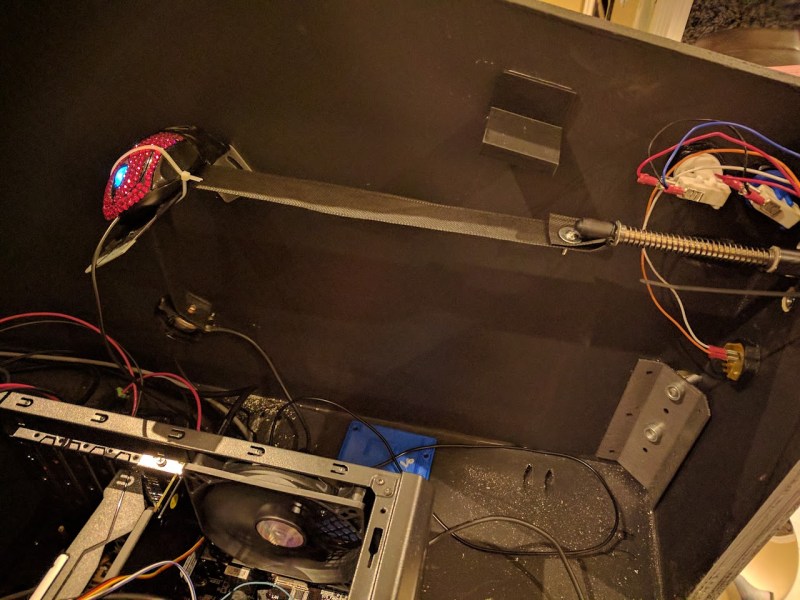Restoring pinball machines is an excellent hobby, and can even be more than that as we see businesses like bars and museums focusing on them as a main attraction. There’s all kinds of intrigue to be found, from esoteric mechanical systems to classic electronics and unique artwork. For those building new pinball machines, though, one way to bypass a lot of the hassle of finding antiquated parts is to build a digital machine with an analog feel, like this machine which repurposes a computer mouse in an interesting way.
One of the important design considerations with a more modern system like this is to preserve the mechanical components that the player interacts with, in this case the plunger. This pinball machine is really just a large screen driven by a computer, but the plunger is a spring-loaded one from an old analog machine. Attached to the end of the plunger inside the cabinet is a cloth strap which passes underneath an old optical mouse. When the plunger is pulled and released, the mouse registers the position of the plunger and sends that information to the computer controlling the pinball display.
We really appreciate a KISS-style design like this in general. Mice are a proven, reliable technology and the metal components of the plunger are unlikely to ever wear out, which means that at least this part of the new pinball machine is unlikely to need much maintenance over the lifespan of the cabinet itself. For other ways of preserving the original feel of old machines, take a look at this build which incorporates all kinds of tricks within a MAME cabinet.

















old analog machine?? you probably mean normal real life pinball machine.
You mean relays and counter-steppers with switches and other “digital” electronics. Lotsa little light-bulbs, and power solenoids.
You described analog elements
The last video in the gallery seems to show that he replaced the cloth with a wooding stirring stick at some point, but this article makes no mention of this. I hope the maker chimes in on what works better.
The flat stick would almost have to be better, given the flop that the strap did whenever they released the plunger probably hurt accuracy and that the strap might bind up from time to time.
the paint-stick is the suggested method currently. The strap worked fine but with nudging you would hear the weight ‘smack’ around…
The software and thread about this idea is here: https://www.vpforums.org/index.php?showtopic=38064
Thanks!
I’ve been involved in virtual pinball cabinets for a few years and have built my own. This “trick” of using a mouse as an optical sensor attached to the plunger is very common, though it’s far more usual to use a wooden or plastic ruler rather than a cloth strip which is what you’re seeing here simply for endurance… though this is a “poverty” method of achieving an analog plunger. A better method is to use a slide potentiometer attached to the plunger by means of a 3D printed bracket which gives you about 1mm accuracy. In mine I used an optical sensor reading a laser printed scale on a mirrored PVC surface rendering about 0.1mm accuracy. It’s probably the most complex method, but it’s also the best result for a “real feel”. There’s a couple of “commercial-ish” kits with optical sensors available on the market.
Still this method does work to get your physical plunger working, you can use bits that are probably laying around your house for free, and is not technically challenging.
I was expecting a totally different kind of story from that headline…
You’re not the only one, my friend 😆
This is the time of year when mice are looking for a warm home.
This is cool, it now has me wondering if a 4k or 8k 32-50″ TV has the kind of resolution to make the pinball game look good. Predicting AI and raytraced pinball emulators.
FWIW, head tracking–usually through BAM–is even more important than the screen resolution for making any game that supports it look good, as the playfield image will shift depending on the player’s head position. It *REALLY* looks impressive and immersive.
Framerate’s more important to a V-Pin than resolution.